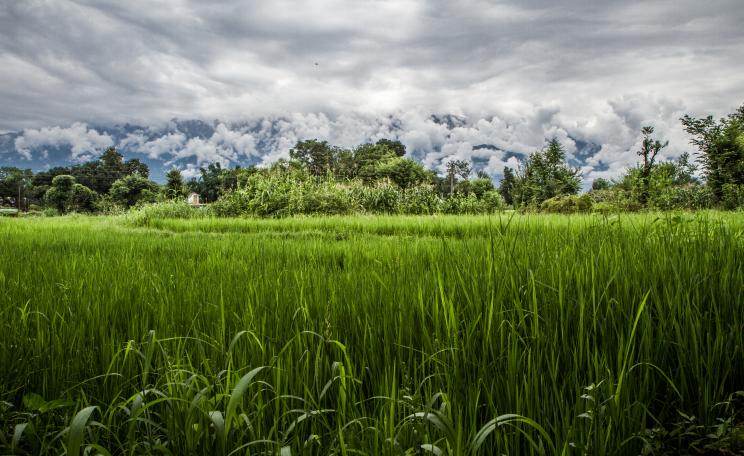Despite emerging from the disgrace of food deficiency to an era of self-sufficiency, India has around the same proportion – 24 per cent – of undernourished people as it did two decades ago. That is because food sufficiency itself is a myth, with much of India’s poor unable to afford a proper meal.
Violent dust and lightning storms have torn through the plains of northern India - including the capital city of New Delhi - and have left more than a trail of death and devastation in their wake.
The weather that has till now claimed 143 lives and maimed hundreds others, many in house collapses, presages a desertifying India that is fast losing some 30,000 hectares of arable land a year, gravely threatening food security for its teeming millions.
This country of 1.28 billion is bracing itself for further such onslaughts that are already being forecast. With lives shattered, families scattered, homes demolished, trees and electricity poles flattened, and water sources contaminated by the swirling dust, authorities are hard pressed to extend relief to men and material quickly enough.
Progressively drier
The unseasonal storms have afflicted over 100 million who have not only lost their family members, but also their cattle and crops.
While farmlands were clogged by precipitating dust or swept away by torrential rains, entire districts plunged into darkness as falling electricity poles snapped power cables. Fires broke out in other places, and lives and livelihood crumpled all around.
Climate change has been increasingly baking much of the Indo-Gangetic, or North Indian, Plains, at 45 degrees Celsius and above in summer, while causing deluges during the four months of monsoon from June.
This land mass is made up of alluvial soil constituted of clay, silt and sand deposited by the mighty Ganges and Brahmaputra rivers that drain the region, yielding half of the country’s foodgrains.
The plains get progressively drier toward the west where they culminate in the That - also called the Great Indian Desert - which covers an expanse of 200,000 square kilometres that abuts Pakistan.
Inappropriate agriculture
Thar was a lush terrain millennia ago, until sand and silt particles lifted by strong winds from the alluvial sediments got deposited in the region.
An official study undertaken at the behest of the Ministry of Environment, Forests & Climate Change (MoEF&CC) finds that 96.4 million hectares (mhas) - nearly 30 per cent of India’s land area of 328.72 mhas (3.29 million sq km) - are now degraded or face desertification.
“Population pressure has resulted in over exploitation of land for cultivation, grazing, water resources and deforestation, leading to degradation of drylands,” says the report, prepared by the Indian Space Research Organisation (ISRO) and 19 other institutes after analysing satellite images.
Drawing attention to the increased pace of land degradation - broadly defined as loss of agricultural productivity – the study reveals that 26 of India’s 29 states have been registering rising desertification over the past decade, with more than 50 per cent of land in five of them under desertification.
Despite emerging from the disgrace of food deficiency to an era of self-sufficiency, India has around the same proportion – 24 per cent – of undernourished people as it did two decades ago. That is because food sufficiency itself is a myth, with much of India’s poor unable to afford a proper meal.
A tenth of all desertification has been caused by the loss of soil cover, largely driven by rainfall and surface runoff. Fertile lands are becoming fallow also because of drought, or inappropriate agriculture.
Farm distress
Any impact on agriculture – whether through drought, flooding, or other natural or manmade calamity – can be particularly ruinous for India, which, despite its sheen of a rampaging economy, is predominantly agrarian, with 55 per cent of its population dependent on farming as the principal source of work and income security.
As one of the world’s largest agrarian economies, India’s farm sector contributes 17.32 per cent to the GDP. Over half of India’s total land area is arable, but productivity is pitiful owing to fractured and marginal land holdings, imperfect market conditions and lack of backward and forward linkages that stunt farm incomes.
India’s social situation is unique, leagues apart from the commercial and automated farm factories of the developed world, with 60 per cent of India’s 253 million farmers holding an average 0.4 hectare each and another 20 per cent, 1.4 hectare each.
There are 116 million farms in the country and cropped area is shrinking instead of expanding, desertification being a major cause. Since 1995-96, the average size land-holding has decreased from 1.4 hectares to 1.15 hectares, translating into a loss of 30,000 hectares of cultivable land each year. The population in this period has swelled by over 300 million.
Farm distress is consequently glaring, with an estimated 200,000 farmers having committed suicide since 1997, an average of upwards of 10,000 every year. This high mortality has resulted primarily from loan defaults, especially in times of crop failure, decreasing profitability, water scarcity, depleting soil health, land fragmentation, inappropriate seeds and inadequate credit.
Political neglect
Despite emerging from the disgrace of food deficiency to an era of self-sufficiency, India has around the same proportion – 24 per cent – of undernourished people as it did two decades ago. That is because food sufficiency itself is a myth, with much of India’s poor unable to afford a proper meal.
Over 260 million men, women and children are undernourished, subsisting on 260 kilocalories per day, when the minimum dietary energy requirement is for 1,770 and the global average, 2,240.
Forty-three per cent of children below five in India suffer from malnutrition, in contrast to seven per cent for China. Malnutrition besides accounts for nearly half the child deaths in India, the prevalence of underweight children almost twice that in Sub-Saharan Africa.
The Washington-based International Food Policy Research Institute ranked India 100th among 119 countries in its Global Hunger Index 2017. The country’s position was poorer even than its impoverished neighbours like Nepal (72), Myanmar (77), Bangladesh (88) and Sri Lanka (84). China ranked 29, and even North Korea, at 93, and Iraq, at 78, fared better.
Agriculture is clearly one sector to have fared poorly owing to political neglect, despite farmers constituting an enormous nationwide vote-bank. Though its role remains critical in the Indian context, agriculture has seen its share in GDP decline from 29.76 to 17.32 per cent over the past 20 years.
Foreign producers
Evidently, the government is anxious to expand the weightage of the services industry – the “new economy” – in the overall GDP. Services enjoys a 54 per cent share in the GDP and clocked 8.3 per cent growth in 2017-18, while agriculture grew at a rate of 2.1 per cent. Moreover, while India’s exports of farm products were worth $30 billion that year, software exports recorded revenues of $167 billion.
As desertification progresses and smothers the croplands, India will need to increasingly import its food requirements.
The long term impact of this on commodity markets worldwide can well be significant. In January 2016, India made its first purchases of corn in 16 years and it has also been increasing purchases of other products, such as lentils and oilmeals, as production falls short.
In the two years between 2014-15 and 2016-17, India’s import bill for cereals, including wheat, rice and maize, surged a staggering 6,623 per cent, and its agrarian imports in 2015-16 alone cost the country $21 billion.
While these imports are resorted to for checking domestic food inflation, it aggravates the condition of the Indian farmers who see them as benefiting foreign producers at the cost of the locals.
Combating desertification
India is a signatory to the United Nations Convention on Combating Desertification (UNCCD) that was adopted in 1994 - two years after the Rio Earth Summit - to become a legally binding international agreement linking environment and development to sustainable land management.
India has since prepared its National Action Programme on this issue and has committed to combat desertification and land degradation and achieve land degradation neutral status by 2030. MoEF&CC is the nodal Ministry for executing this.
Alarmingly, it does not have a specific policy or legislative framework for combating desertification as such, and has no coherent plan to reverse this process or its impact.
This Author
Sarosh Bana is executive editor of Business India.




